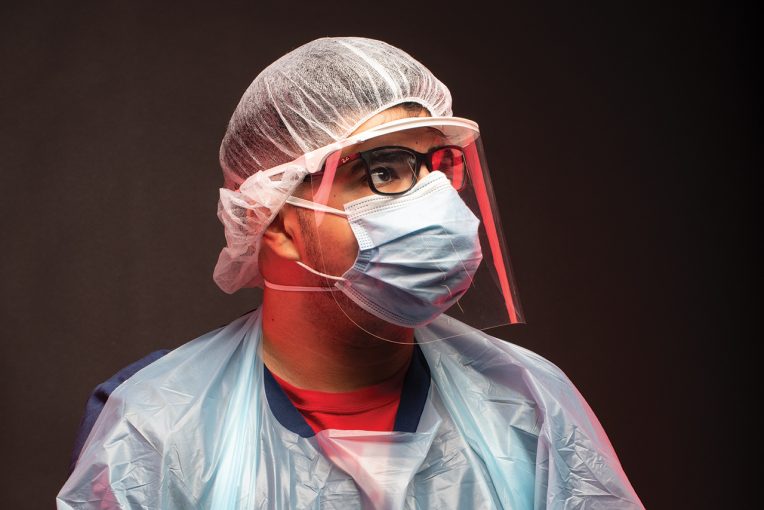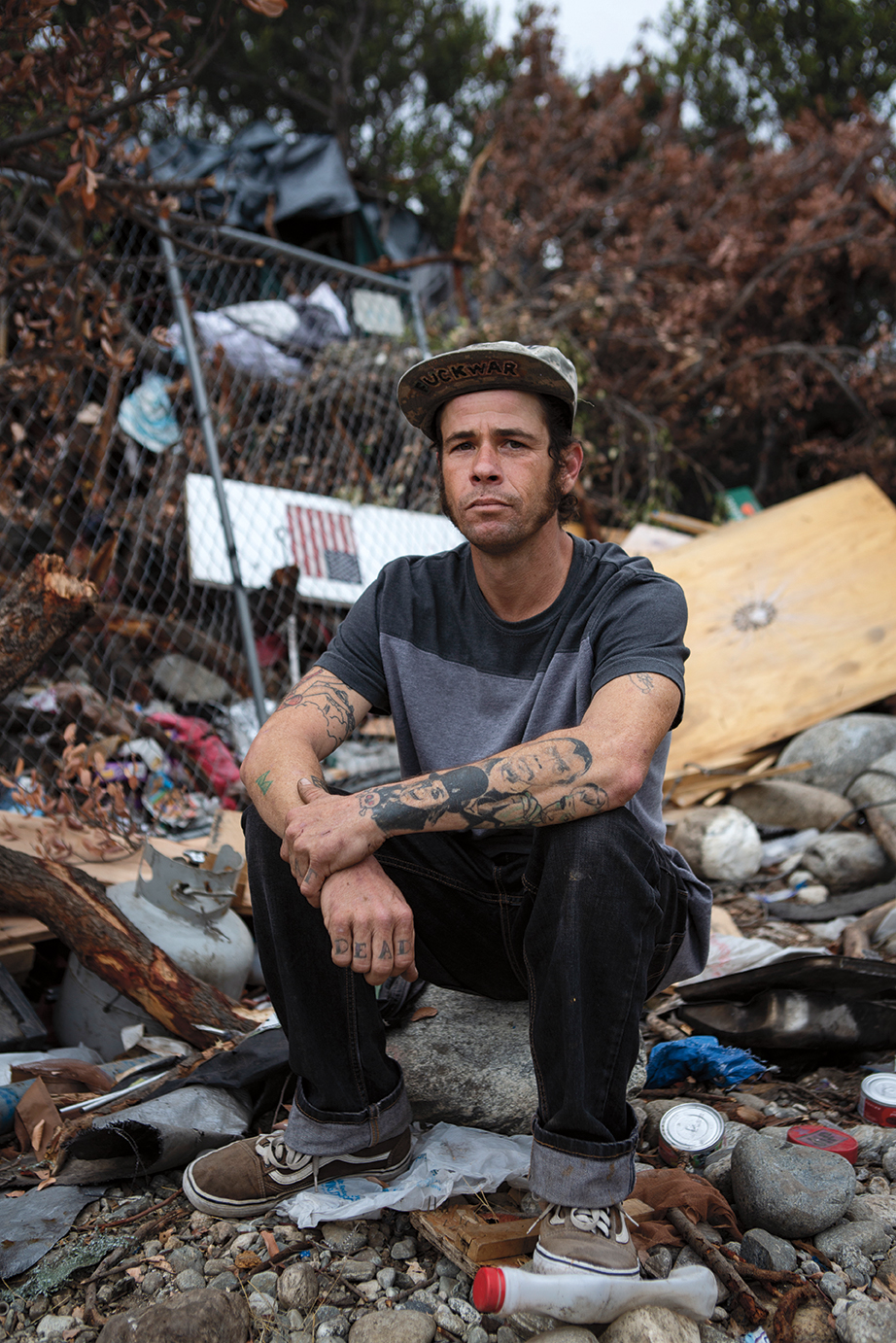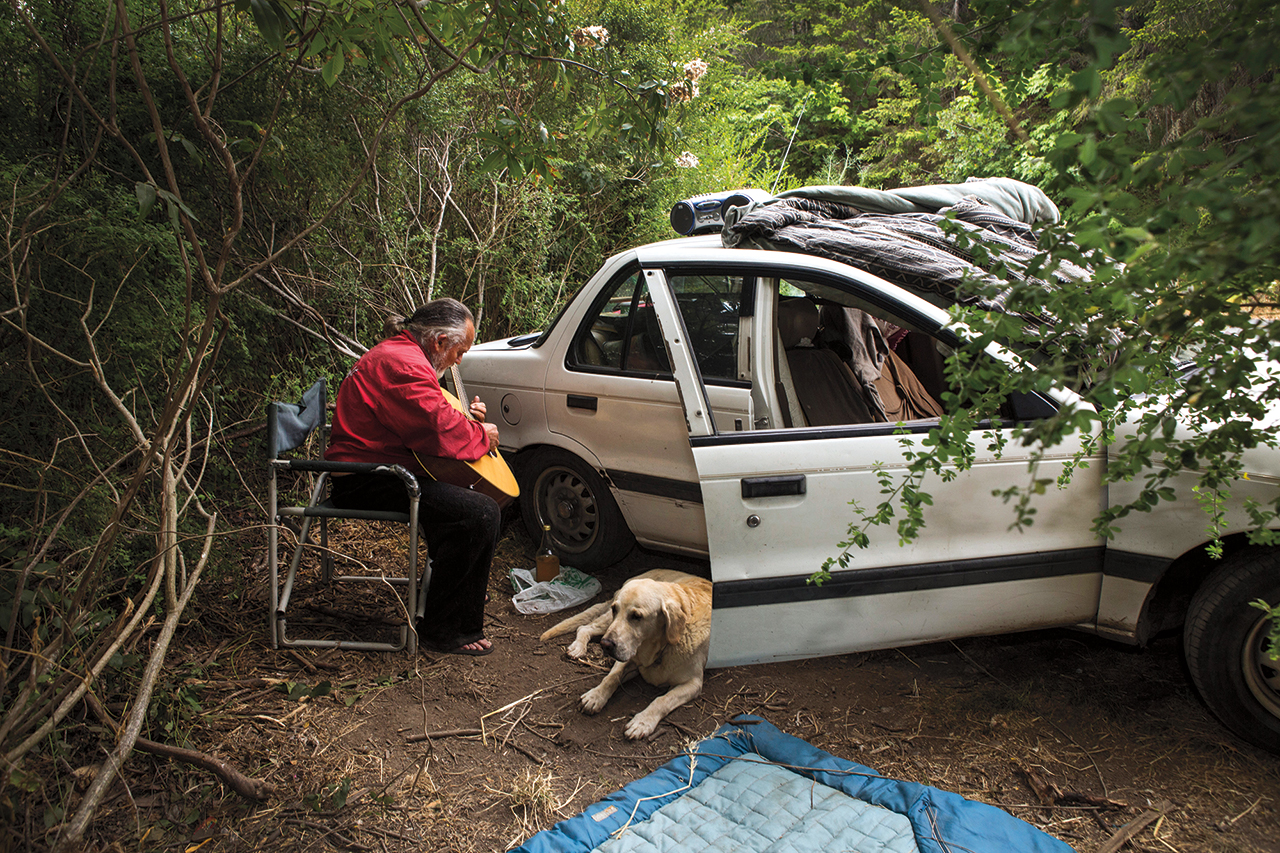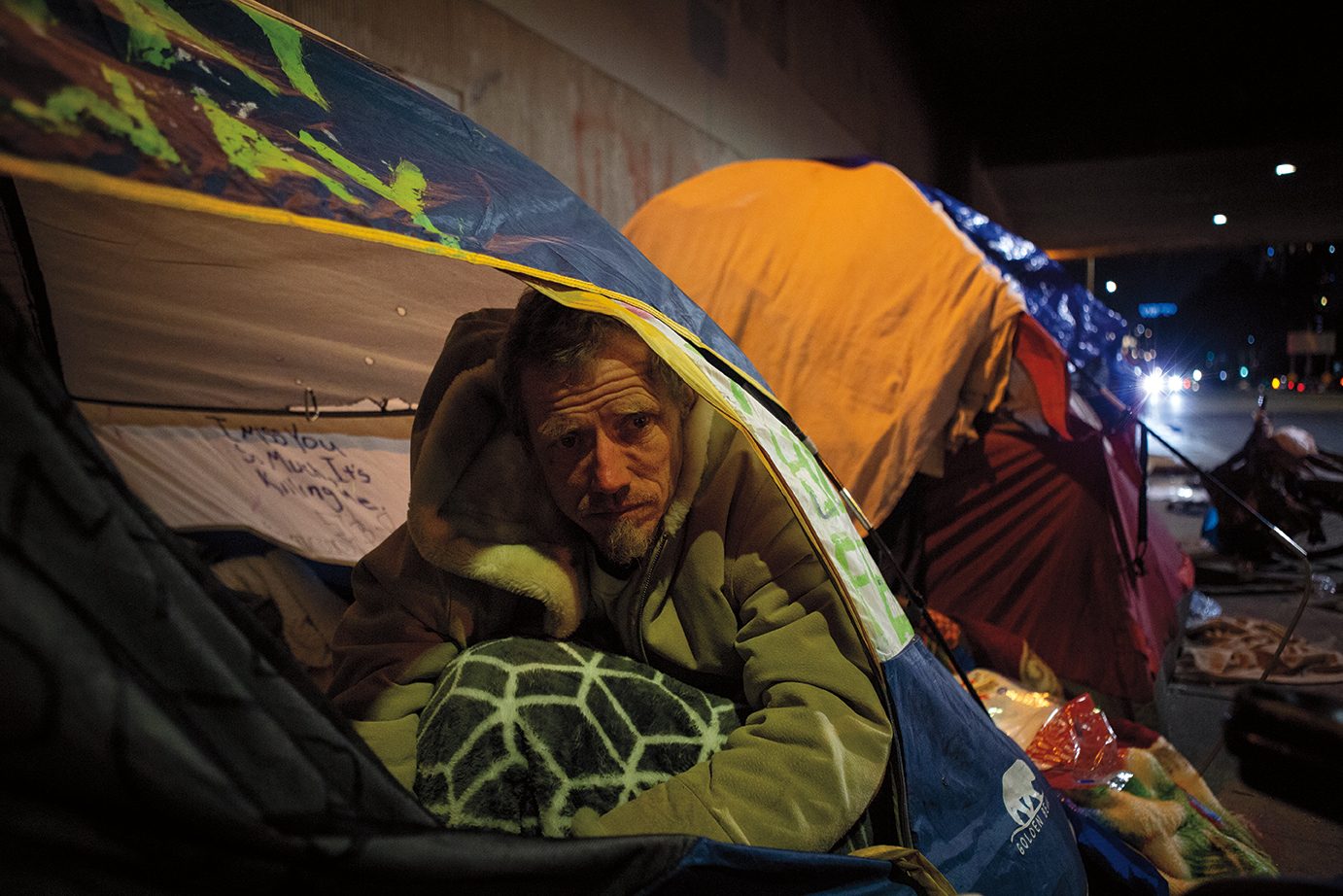For months, the nation has been bombarded with details of how the coronavirus (COVID-19) has brought heartache to families as loved ones perished. Health care workers became our heroes who worked with limited supplies and at their own peril to care for the ill, many of whom died with a nurse at their side because visitors were not allowed.
A second prominent and repeated headline has been the economic impact. Jobs were lost and unemployment soared during the weeks of mandatory quarantine. Businesses permanently closed and countless families were left with debt that mounted as resources disappeared.
Appears InThose hardest hit by the pandemic consequently fall on opposite ends of the spectrum— from health care to the homeless. Each group has been the focus of an alum determined to make a difference in the lives of those who have struggled to survive the pandemic.
Nursing through a nightmare
by Kate Arthur

Sometimes it’s difficult to breathe. Over a 12-hour shift, Angel Pulido ’15 feels each warm breath under a sealed mask. Each day he pulls on a mask, gown, and gloves. He knows that no matter how careful, his precautions might not be enough.
“Being on the front lines and having to expose yourself to the virus, it’s scary,” he said. “You think to yourself, ‘Am I going to get the virus today? Am I going to get sick?’ There’s a lot of uncertainty. Every day is new. It gets exhausting.”
As a nurse on the medical/surgical unit in the John H. Stroger Jr. Hospital of Cook County Health in Chicago, Pulido usually cares for patients recovering from surgery or suffering heart failure, kidney or lung disease. In March, his floor turned into a COVID-19 unit, where he cared for patients who were stable but so weak some couldn’t hold a toothbrush.
Everything changed. The most difficult transition wasn’t learning a new procedure or treatment. It was instead something he couldn’t do—spend time talking to patients, hearing their stories, getting to know their families. No visitors were allowed, and he had to move in and out of rooms quickly to minimize his exposure.
“It’s hard because some of these patients have been in for weeks and have to go through this alone,” he said. “I can’t imagine myself in that situation. I would be devastated because my family is everything to me.”
At the end of his shift, he stores the mask that he uses up to two weeks. He disposes of his gloves, gown, and shoe covers and begins the 45-minute commute to his apartment. What used to be a smooth transition from work to home, now takes miles to clear his mind.
“Our job in the nursing field is to help you get to where you were before you got sick, to make sure you can go live your life,” he said. “Now we have cases where patients sometimes don’t recover, or take a lot longer to recover. Sometimes I come home and think, ‘What if I would have done this differently today? Would that have affected the outcome?’”
Like everybody else, Pulido had plans before the pandemic. He and his girlfriend wanted to go to Disneyland. They were going to visit Mexico, the country his grandparents left as immigrants.
Instead he spent months in his apartment, only leaving for work and to get essentials, dropping groceries off to his parents who live 10 minutes away. He couldn’t watch the news. He started teaching himself guitar to relax.
Pulido grew up on the north side of Chicago. His mother worked factory night shifts to provide for him and his sister. College didn’t seem like a possibility, but he knew he wanted to do something where he’d interact with people.
“I’ve always had a big heart and want to help people anyway I can,” he said.
When former ISU recruiter Dave Marcial, M.A. ’07, visited his high school, they talked about Pulido’s dreams. He didn’t know how to apply to colleges and had never set foot on a campus. Marcial invited him to tour Illinois State. Pulido made that visit and connected with other Hispanic students.
“It was all people who looked like me, people of color,” he said. “It really felt like I was joining a family right away.” His mother encouraged him, even though it was two hours from family, which was a long way for Pulido.
“She wasn’t going to let me not go to college,” he said. “She kept track of the deadlines. It was because of her strength and courage that I was even able to consider it.”
He applied to the Mennonite College of Nursing program, but didn’t get in. He came to campus anyway, hoping to earn his way in and planning to transfer if he didn’t. “That motivated me to put even more work into classes because I didn’t want to leave campus.” He was admitted as a sophomore.
“You learn how to cope and be mindful of controlling what you can.”—Angel Pulido
Pulido found a second home in the Office of Admissions, where he worked three years as an ambassador. Now he’s encouraging a generation that won’t enter college until 2032, his 5- and 6-year-old nieces.
“I tell them, ‘Just because we’re Hispanic and of color, and statistics don’t really work with us, that doesn’t mean it’s impossible.’”
Graduation day was emotional for Pulido and his family.
“To be able to put on your cap and gown, to cross the stage and shake hands with the dean, to take the oath you take as a nurse, it’s just surreal. Hearing your name, looking for your family and waving to them, it was one of the greatest moments of my life.”
Five years later, he’s in a far different moment in the middle of a global pandemic, caring for those sickened by a virus that’s infected more than 14.5 million worldwide.
“You learn how to cope and be mindful of controlling what you can,” he said. “It’s been tough but at the same time, it’s fun being able to be on the front line and part of something I could never have imagined in a million years.”
More powerful than 1,000 words
by Nick Erickson
Rachel Bujalski ’11 has always considered herself an artist. Growing up in suburban Chicago, she was readily equipped with paintbrushes, markers, and pastels to tap into her creative senses. Opportunity awaited with every blank page.
As she got older, Bujalski found fulfillment with another tool: the camera. The world became her canvas.
Nowadays the former Vidette photo editor is capturing harrowing and humbling moments of humanity as a freelance photojournalist. Bujalski, whose work has been featured in The New York Times, The Washington Post, The Wall Street Journal, National Geographic, and on ESPN and CNN—just to name a few—has spent the last eight years living in southern and northern California amplifying the voices that are sometimes hard to hear. She documents and examines the lifestyles of the homeless population and people, as she describes in her biography, “living on the fringes of society that make up American culture today.”
Bujalski can’t recall encountering a single homeless person while growing up in Geneva and attending Illinois State. That changed upon her arrival to Venice Beach in 2012. Taken aback by the tented-covered streets filled with cardboard signs pleading for help, she began to search for solutions.
“I was so blown away by it and wanted to know why,” said Bujalski, who graduated with degrees in art education and studio arts. “Where are we going wrong? There were a lot of questions, and using my camera was my way of talking to people and getting answers.”
Bujalski has spent her career traversing the streets to learn the stories of some of the population’s most vulnerable members. Her reporting unmasks problems such as affordable housing, wealth distribution, and an ever-changing job climate. The COVID-19 pandemic has only intensified those issues, forcing citizens out of their homes and to the streets.
“I think it’s really exposed that we keep ignoring big issues like housing,” Bujalski said. “It’s exposing that we are not doing enough and are looking away more than looking in and asking questions and connecting with our neighbors.”
Even before the virus hit, statistics were alarming. According to a 2019 report from Harvard’s Joint Center for Housing, 42 percent of Californians said they struggled to make ends meet. With the median price for a Los Angeles home at $600,000, it is hard for folks to afford adequate housing. During the pandemic places such as gyms, libraries, and soup kitchens were closed to meet social distancing guidelines, thus eliminating various shelters the homeless population uses. Bujalski shared these challenges in an op-ed piece, titled “On the Streets of Los Angeles,” she wrote for The New York Times, which published on April 4.
Bujalski said big misconceptions of the homeless population are that many are mentally ill and addicted to drugs. She said that stereotype doesn’t represent reality, as more people take to the streets because they feel as though they don’t have a financial choice.
“People are living paycheck to paycheck,” Bujalski said. “It can be your neighbor that is a month away from being homeless. It could be your Uber driver. It can be anybody.”
This reality has been proven during the pandemic. With non-essential businesses forced to shut down as stay-at-home orders were executed throughout the country, many citizens dependent on an immediate source of income could no longer afford to pay rent or mortgages.
Bujalski has built herself a platform to tell these types of stories. Her work has been featured in big-time publications and websites all over the globe. In 2013, she co-founded the Mirror Mirror Project, which creates connections between artists and homeless youth in an effort to breakdown stereotypes. In 2015, her photo series titled “Connected Off the Grid” gained syndication with The Story Institute, an international storytelling platform, and in 2018 was exhibited at the The International Center of Photography Museum in New York City.
She’s won numerous awards, including two first-place prizes from the Illinois Collegiate Press Association for work she did with The Vidette in 2010. Her talents include producing short film documentaries and appearing on podcasts.
Because of her efforts to simply approach people in their most vulnerable moments and exhibit enough of a human conscious to build a trust with this population, thousands of eyes have gotten a glimpse into this homeless community.
Bujalski wants people to become more curious and seek to answer the whys, and she especially hopes change will come after the pandemic. She has outlined a picture of homelessness in America. It’s up to its citizens and government leaders to fill in the rest of it.
“It takes just a little bit of our effort to ask what their stories are,” she said. “That’s the empathy we are missing now in the world today. Humans need to connect with each other.”






